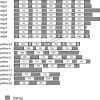Evolution of the Yellow/Major Royal Jelly Protein family and the emergence of social behavior in honey bees
- PMID: 17065613
- PMCID: PMC1626640
- DOI: 10.1101/gr.5012006
Evolution of the Yellow/Major Royal Jelly Protein family and the emergence of social behavior in honey bees
Abstract
The genomic architecture underlying the evolution of insect social behavior is largely a mystery. Eusociality, defined by overlapping generations, parental brood care, and reproductive division of labor, has most commonly evolved in the Hymenopteran insects, including the honey bee Apis mellifera. In this species, the Major Royal Jelly Protein (MRJP) family is required for all major aspects of eusocial behavior. Here, using data obtained from the A. mellifera genome sequencing project, we demonstrate that the MRJP family is encoded by nine genes arranged in an approximately 60-kb tandem array. Furthermore, the MRJP protein family appears to have evolved from a single progenitor gene that encodes a member of the ancient Yellow protein family. Five genes encoding Yellow-family proteins flank the genomic region containing the genes encoding MRJPs. We describe the molecular evolution of these protein families. We then characterize developmental-stage-specific, sex-specific, and caste-specific expression patterns of the mrjp and yellow genes in the honey bee. We review empirical evidence concerning the functions of Yellow proteins in fruit flies and social ants, in order to shed light on the roles of both Yellow and MRJP proteins in A. mellifera. In total, the available evidence suggests that Yellows and MRJPs are multifunctional proteins with diverse, context-dependent physiological and developmental roles. However, many members of the Yellow/MRJP family act as facilitators of reproductive maturation. Finally, it appears that MRJP protein subfamily evolution from the Yellow protein family may have coincided with the evolution of honey bee eusociality.
Figures




Similar articles
-
Origin and function of the major royal jelly proteins of the honeybee (Apis mellifera) as members of the yellow gene family.Biol Rev Camb Philos Soc. 2014 May;89(2):255-69. doi: 10.1111/brv.12052. Epub 2013 Jul 16. Biol Rev Camb Philos Soc. 2014. PMID: 23855350 Review.
-
The family of major royal jelly proteins and its evolution.J Mol Evol. 1999 Aug;49(2):290-7. doi: 10.1007/pl00006551. J Mol Evol. 1999. PMID: 10441680
-
Honeybee (Apis mellifera L.) mrjp gene family: computational analysis of putative promoters and genomic structure of mrjp1, the gene coding for the most abundant protein of larval food.Gene. 2003 Jan 16;303:165-75. doi: 10.1016/s0378-1119(02)01174-5. Gene. 2003. PMID: 12559578
-
The MRJP/YELLOW protein family of Apis mellifera: identification of new members in the EST library.J Insect Physiol. 2004 Jan;50(1):51-9. doi: 10.1016/j.jinsphys.2003.09.008. J Insect Physiol. 2004. PMID: 15037093
-
Genetic underpinnings of division of labor in the honeybee (Apis mellifera).Trends Genet. 2013 Nov;29(11):641-8. doi: 10.1016/j.tig.2013.08.002. Epub 2013 Sep 6. Trends Genet. 2013. PMID: 24012355 Review.
Cited by
-
Characteristics of dr1790 disruptant and its functional analysis in Deinococcus radiodurans.Braz J Microbiol. 2015 Jun 1;46(2):601-11. doi: 10.1590/S1517-838246220131018. eCollection 2015 Jun. Braz J Microbiol. 2015. PMID: 26273280 Free PMC article.
-
Mechanisms regulating caste differentiation in an aphid social system.Commun Integr Biol. 2010 Jan;3(1):1-5. doi: 10.4161/cib.3.1.9694. Commun Integr Biol. 2010. PMID: 20539772 Free PMC article.
-
Beyond Royalactin and a master inducer explanation of phenotypic plasticity in honey bees.Commun Biol. 2018 Jan 22;1:8. doi: 10.1038/s42003-017-0004-4. eCollection 2018. Commun Biol. 2018. PMID: 30271895 Free PMC article. Review.
-
Architecture of the native major royal jelly protein 1 oligomer.Nat Commun. 2018 Aug 22;9(1):3373. doi: 10.1038/s41467-018-05619-1. Nat Commun. 2018. PMID: 30135511 Free PMC article.
-
New Insights into the Biological and Pharmaceutical Properties of Royal Jelly.Int J Mol Sci. 2020 Jan 8;21(2):382. doi: 10.3390/ijms21020382. Int J Mol Sci. 2020. PMID: 31936187 Free PMC article. Review.
References
-
- Albert S., Klaudiny J., Klaudiny J. The MRJP/YELLOW protein family of Apis mellifera: Identification of new members in the EST library. J. Insect Physiol. 2004;50:51–59. - PubMed
-
- Albert S., Bhattacharya D., Klaudiny J., Schmitzova J., Simuth J., Bhattacharya D., Klaudiny J., Schmitzova J., Simuth J., Klaudiny J., Schmitzova J., Simuth J., Schmitzova J., Simuth J., Simuth J. The family of major royal jelly proteins and its evolution. J. Mol. Evol. 1999a;49:290–297. - PubMed
-
- Albert S., Klaudiny J., Simuth J., Klaudiny J., Simuth J., Simuth J. Molecular characterization of MRJP3, highly polymorphic protein of honeybee (Apis mellifera) royal jelly. Insect Biochem. Mol. Biol. 1999b;29:427–434. - PubMed
-
- Albertova V., Su S., Brockmann A., Gadau J., Albert S., Su S., Brockmann A., Gadau J., Albert S., Brockmann A., Gadau J., Albert S., Gadau J., Albert S., Albert S. Organization and potential function of the mrjp3 locus in four honeybee species. J. Agric. Food Chem. 2005;53:8075–8081. - PubMed
-
- Artero R., Furlong E.E., Beckett K., Scott M.P., Baylies M., Furlong E.E., Beckett K., Scott M.P., Baylies M., Beckett K., Scott M.P., Baylies M., Scott M.P., Baylies M., Baylies M. Notch and Ras signaling pathway effector genes expressed in fusion competent and founder cells during Drosophila myogenesis. Development. 2003;130:6257–6272. - PubMed
Publication types
MeSH terms
Substances
Grants and funding
LinkOut - more resources
Full Text Sources
